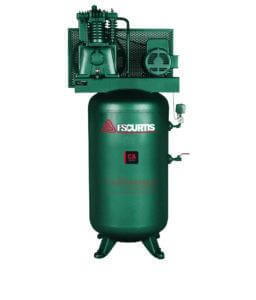Choosing between a refrigerated or desiccant air dryer is dependent on the acceptable moisture content or pressure dew point (PDP) requirement for your application.
Refrigerated air dryers are typically adequate for general purpose compressed air applications and will typically offer anywhere from a 35-40° F pressure dew point (PDP). Cost is typically much less than that of other drying technologies. Refrigerated dryers use a refrigeration compressor and heat exchange to cool the compressed air and remove moisture. There are two types of refrigerated dryers. The first type is cycling, which is the more energy efficient option and typically used for higher flows and where the flow rate varies from shift to shift. The Cycling or VSD refrigerated dryer, cycles on and off to deliver the correct PDP at the varying flow rate. The other and less expensive option is a non-cycling type. Non-cycling dryers are on all the time and run at the same load as long as they are switched on. The difference between the two, is like running your home refrigerator. You only open it when needed, and thus it “cycles” on and off as needed. Leave the door open all the time, and now you have a “non-cycling” refrigerator. Both types of dryers should have a coalescing pre-filter to remove large quantities of water droplets and oil mist before going into the air dyer. This helps the air dryer to be more efficient in removing moisture from the compressed air. After the dryer, “after-filters” can clean up the remaining oil-mist, particles and hydrocarbons. The type of final filter(s) is dependent upon your air systems’ ISO Air Quality Standard.
Desiccant compressed air dryers are typically used when your application requires very dry compressed air or when the compressed air supply runs in cold environments. Desiccant dryers can achieve dew points as low as -100. In some facilities, a desiccant air dryer may only be needed for certain applications and processes. As an example, an auto body shop generally will need only a refrigerate air dryer for the tools and general air uses, but will benefit from having very clean and dry air for the paint booth. In a twin towered desiccant dryer the desiccant attracts the moisture during the timed cycle and then purges, which releases the moisture to the atmosphere. While one tower is drying, the other is purging and regenerating. This type of dryer does use a portion of the dried compressed air as part of the purge cycle so you need to be sure to supply enough compressed air for both your demand and the purge requirement.
The different types of desiccant dryers can include non-heated, heated purge and blower purge. More energy efficient desiccant dryers will use heated ambient air to purge the off-line tower. Further energy savings can be achieved by using a PDP monitor connected to the dryer controller which will determine when to switch the towers to start the regeneration cycle of the spent tower. The added cost of a blower purge dryer will be quickly off-set by the compressed air system energy savings in most cases.
Desiccant air dryers require a high-quality oil-mist removal pre-filter, and a particle filter to keep dust and very fine particles from the dryer bed from getting down-stream to the air distribution system





